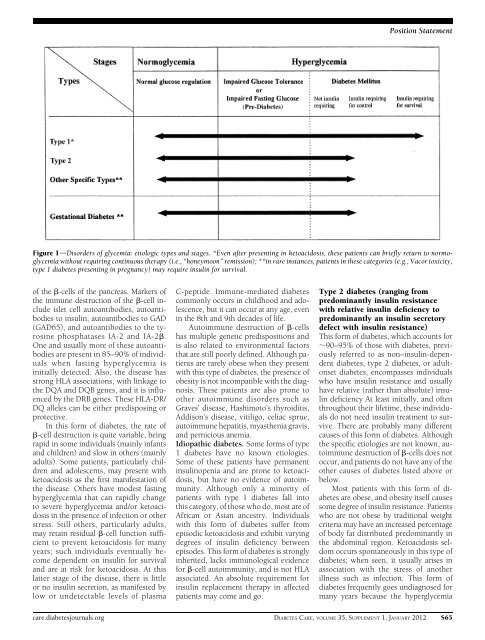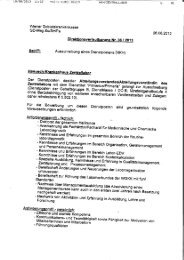Diagnosis and Classification of Diabetes Mellitus
Diagnosis and Classification of Diabetes Mellitus
Diagnosis and Classification of Diabetes Mellitus
You also want an ePaper? Increase the reach of your titles
YUMPU automatically turns print PDFs into web optimized ePapers that Google loves.
Position Statement<br />
Figure 1dDisorders <strong>of</strong> glycemia: etiologic types <strong>and</strong> stages. *Even after presenting in ketoacidosis, these patients can briefly return to normoglycemia<br />
without requiring continuous therapy (i.e., “honeymoon” remission); **in rare instances, patients in these categories (e.g., Vacor toxicity,<br />
type 1 diabetes presenting in pregnancy) may require insulin for survival.<br />
<strong>of</strong> the b-cells <strong>of</strong> the pancreas. Markers <strong>of</strong><br />
the immune destruction <strong>of</strong> the b-cell include<br />
islet cell autoantibodies, autoantibodies<br />
to insulin, autoantibodies to GAD<br />
(GAD65), <strong>and</strong> autoantibodies to the tyrosine<br />
phosphatases IA-2 <strong>and</strong> IA-2b.<br />
One <strong>and</strong> usually more <strong>of</strong> these autoantibodies<br />
are present in 85–90% <strong>of</strong> individuals<br />
when fasting hyperglycemia is<br />
initially detected. Also, the disease has<br />
strong HLA associations, with linkage to<br />
the DQA <strong>and</strong> DQB genes, <strong>and</strong> it is influenced<br />
by the DRB genes. These HLA-DR/<br />
DQ alleles can be either predisposing or<br />
protective.<br />
In this form <strong>of</strong> diabetes, the rate <strong>of</strong><br />
b-cell destruction is quite variable, being<br />
rapid in some individuals (mainly infants<br />
<strong>and</strong> children) <strong>and</strong> slow in others (mainly<br />
adults). Some patients, particularly children<br />
<strong>and</strong> adolescents, may present with<br />
ketoacidosis as the first manifestation <strong>of</strong><br />
the disease. Others have modest fasting<br />
hyperglycemia that can rapidly change<br />
to severe hyperglycemia <strong>and</strong>/or ketoacidosis<br />
in the presence <strong>of</strong> infection or other<br />
stress. Still others, particularly adults,<br />
may retain residual b-cell function sufficient<br />
to prevent ketoacidosis for many<br />
years; such individuals eventually become<br />
dependent on insulin for survival<br />
<strong>and</strong> are at risk for ketoacidosis. At this<br />
latter stage <strong>of</strong> the disease, there is little<br />
or no insulin secretion, as manifested by<br />
low or undetectable levels <strong>of</strong> plasma<br />
C-peptide. Immune-mediated diabetes<br />
commonly occurs in childhood <strong>and</strong> adolescence,<br />
but it can occur at any age, even<br />
in the 8th <strong>and</strong> 9th decades <strong>of</strong> life.<br />
Autoimmune destruction <strong>of</strong> b-cells<br />
has multiple genetic predispositions <strong>and</strong><br />
is also related to environmental factors<br />
that are still poorly defined. Although patients<br />
are rarely obese when they present<br />
with this type <strong>of</strong> diabetes, the presence <strong>of</strong><br />
obesity is not incompatible with the diagnosis.<br />
These patients are also prone to<br />
other autoimmune disorders such as<br />
Graves’ disease, Hashimoto’s thyroiditis,<br />
Addison’s disease, vitiligo, celiac sprue,<br />
autoimmune hepatitis, myasthenia gravis,<br />
<strong>and</strong> pernicious anemia.<br />
Idiopathic diabetes. Some forms <strong>of</strong> type<br />
1 diabetes have no known etiologies.<br />
Some <strong>of</strong> these patients have permanent<br />
insulinopenia <strong>and</strong> are prone to ketoacidosis,<br />
but have no evidence <strong>of</strong> autoimmunity.<br />
Although only a minority <strong>of</strong><br />
patients with type 1 diabetes fall into<br />
this category, <strong>of</strong> those who do, most are <strong>of</strong><br />
African or Asian ancestry. Individuals<br />
with this form <strong>of</strong> diabetes suffer from<br />
episodic ketoacidosis <strong>and</strong> exhibit varying<br />
degrees <strong>of</strong> insulin deficiency between<br />
episodes. This form <strong>of</strong> diabetes is strongly<br />
inherited, lacks immunological evidence<br />
for b-cell autoimmunity, <strong>and</strong> is not HLA<br />
associated. An absolute requirement for<br />
insulin replacement therapy in affected<br />
patients may come <strong>and</strong> go.<br />
Type 2 diabetes (ranging from<br />
predominantly insulin resistance<br />
with relative insulin deficiency to<br />
predominantly an insulin secretory<br />
defect with insulin resistance)<br />
This form <strong>of</strong> diabetes, which accounts for<br />
;90–95% <strong>of</strong> those with diabetes, previously<br />
referred to as non–insulin-dependent<br />
diabetes, type 2 diabetes, or adultonset<br />
diabetes, encompasses individuals<br />
who have insulin resistance <strong>and</strong> usually<br />
have relative (rather than absolute) insulin<br />
deficiency At least initially, <strong>and</strong> <strong>of</strong>ten<br />
throughout their lifetime, these individuals<br />
do not need insulin treatment to survive.<br />
There are probably many different<br />
causes <strong>of</strong> this form <strong>of</strong> diabetes. Although<br />
the specific etiologies are not known, autoimmune<br />
destruction <strong>of</strong> b-cells does not<br />
occur, <strong>and</strong> patients do not have any <strong>of</strong> the<br />
other causes <strong>of</strong> diabetes listed above or<br />
below.<br />
Most patients with this form <strong>of</strong> diabetes<br />
are obese, <strong>and</strong> obesity itself causes<br />
some degree <strong>of</strong> insulin resistance. Patients<br />
who are not obese by traditional weight<br />
criteria may have an increased percentage<br />
<strong>of</strong> body fat distributed predominantly in<br />
the abdominal region. Ketoacidosis seldom<br />
occurs spontaneously in this type <strong>of</strong><br />
diabetes; when seen, it usually arises in<br />
association with the stress <strong>of</strong> another<br />
illness such as infection. This form <strong>of</strong><br />
diabetes frequently goes undiagnosed for<br />
many years because the hyperglycemia<br />
care.diabetesjournals.org DIABETES CARE, VOLUME 35, SUPPLEMENT 1, JANUARY 2012 S65




